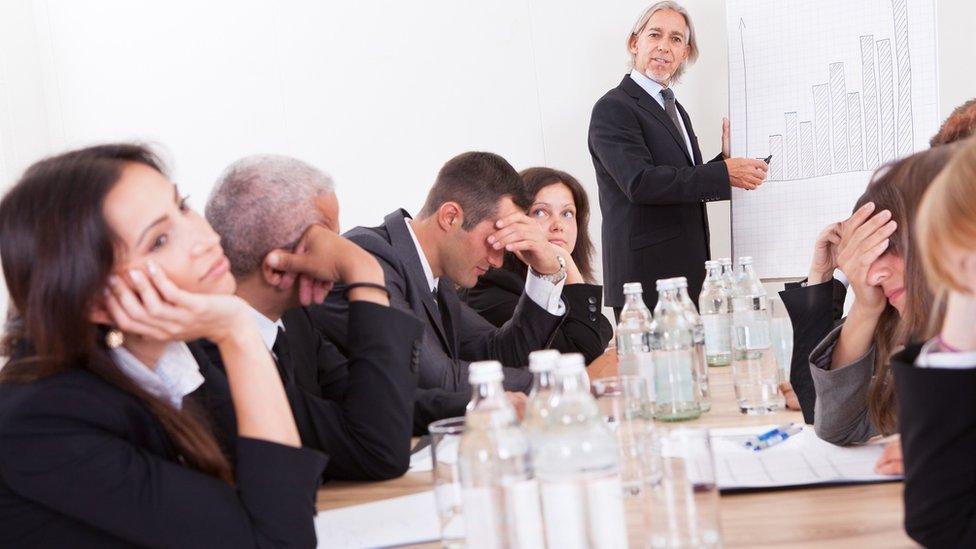How to look interested in a boring meeting
- Published

Adopting a suitable facial expression for a meeting is a skill worth mastering, writes author and Financial Times columnist Lucy Kellaway.
A colleague of the new prime minister was recently asked to describe his boss's style. "She just sits there in cabinet looking exasperated in a poised way."
I read this and a light bulb went on.
To go through meetings looking exasperated but poised is what we should all be aiming for. It is superior but never rude. It is powerful but not dishonest. It is a bit forbidding. A little regal.
It is just perfect.
This question of how to arrange your face when you are sitting round a table at work listening to other people talk is important. The average executive spends about four hours a day in meetings, most of which is spent in silence half-listening to the person talking while studying the faces of the people who are not.
This suggests we have got it all wrong. We fret about the impression we make when we speak, but spend no time worrying about how we come across when we are silent.
The other day I was sent a photo of a panel I had recently been on, taken by someone in the audience.
Two of the panellists are looking away from the person talking. Two appear catatonic. I am looking a little mad, with eyes popping in incredulity and a slight smirk around the mouth. Only one of us got it right. He had composed his face into a mask of polite yet sceptical interest.

The most common expression in meetings is boredom
Our meetings faces are too important to be allowed to compose themselves. The most common look in meetings (at least on the faces of those not talking) is boredom, which is never a good look. The vacant slouch creates an air of gormlessness, while the slack muscles make you look ancient and exhausted.
Being so bored that you go to sleep is the worst look there is. Kay Whitmore, chief executive of Kodak in the 1990s, was more infamous for falling asleep in a meeting with Bill Gates, than for helping to run his company into the ground.
While nodding off is fatal, nodding in general can be excellent. For nine years I sat on the board of a company and so must have spent several hundred hours watching some of the country's finest non-executive directors nod.
It turns out there are different sorts of nods that come in handy at different times. The more complex the material under discussion, the more a medium speed nod makes you look clever and on the ball, while a slower 'I'm considering this' nod can also come in handy.
Otherwise, the rules for meetings faces are the opposite of the rules for office expressions in general.

Smiling too much can come across as sycophantic
While smiling is usually a good plan as it makes other people feel better, in meetings it is to be avoided, unless someone has made a joke, as it can make you look unserious, too keen, and possibly sycophantic. Sucking up, though sometimes necessary, is so demeaning it must never be done in public.
Frowning, generally bad in offices, is essential in meetings. It implies you are thinking deeply and can distance you from whatever decisions are being taken. Better still it implies superiority: you could do it better yourself.
You could say that we are stuck with the expressions we were born with. But that's not true.
I have been spending quite a bit of time in front of the mirror being poised and exasperated. It was hard at first, but I've just tried again and, by George, I think I've got it.
Lucy Kellaway is an author and Financial Times columnist. Listen to her on Business Daily and World Business Report on BBC World Service every Monday.